Scotland's People Annual Report: Results from 2012 Scottish Household Survey
A National Statistics publication for Scotland, providing reliable and up-to-date information on the composition, characteristics, behaviour and attitudes of Scottish households and adults across a number of topic areas including local government, neighbourhoods and transport.
13 Culture and Sport
Introduction and Context
The Scottish Government is committed to promoting and supporting sport and cultural activities because it recognises and values the benefits that sport and culture bring, not only to individuals, but to our communities. The Government's work is focused on widening access and participation and ensuring that the necessary infrastructure is in place to deliver sporting and cultural opportunities whilst promoting a drive to achieve sporting and cultural excellence. This work contributes to the Government's strategic objectives[87], through understanding and monitoring levels of cultural engagement and sporting participation both at the national and sub-national levels and to inform decisions on government and local government policy making. For example, Scottish Household Survey (SHS) data now contributes to National Indicator 41: Increase cultural engagement.
The SHS is the primary source of information on cultural attendance and sporting participation in Scotland and it is the only source of data on attendance and participation at local authority level. Questions on cultural attendance and sporting participation were introduced in the SHS for the first time in 2007. From 2012, It is possible to obtain data for at local authority level every year.
The suite of culture and sport questions within the SHS covers attendance at cultural events and places, and participating in cultural and sports activities. This chapter explores the prevalence and frequency of attending cultural events and places of culture and participating in cultural activities in the last 12 months and of participation in sport in the last 4 weeks.
Main Findings
- Nine-in-ten (90%) of adults have engaged in culture in 2012, either through attending or visiting a cultural event or place or participating in a cultural activity.
- Over three-quarters (78%) have attended a cultural event or place in the last 12 months. The most popular form of cultural attendance is watching films at a cinema (54% of adults) with around a third (31%) attending live music events and theatres.
- Attendance is higher amongst women than men at some, but not all types of cultural place or event. The overall levels of cultural attendance falls with increasing age of respondent. This is partly due to the popularity of cinema attendance amongst younger age groups.
- Over three-quarters (78%) of adults participated in some form of cultural activity in 2012. By far the most popular form of cultural participation is reading for pleasure (69%). Overall participation in cultural activities is higher amongst women (84%) than men (73%), but there are some activities in which participation amongst men is higher.
- Three-quarters of adults (74%) participated in sport (including recreational walking) in the last four weeks. By far the most prevalent activity was walking for 30 minutes (for recreational purposes) with almost six-in-ten (59%) having done this compared with fewer than one-in-five undertaking any other individual activity, with swimming the next biggest at 18%. When walking was excluded, just over half of adults (51%) had undertaken at least one of the remaining sports activities in the last four weeks.
- Overall sports participation is higher for men than women (77% and 72% respectively). This difference is larger when walking is excluded, with 57% of men and 46% of women participating in a sport other than walking.
- Sports participation decreases with age, particularly amongst those aged 45 or older. Around 83% to 84% of adults aged between 16 to 44 participated in a sport in the previous four weeks in 2012. This decreases to 66% of those aged between 60 and 74 and 44% of those aged 75 or older.
- Although headline rates of adult participation in sport have remained generally stable from 2007 to 2012, the frequency of participation amongst those who do take part in sport has increased. In 2007, 23% of participants took part in sport regularly (on 22 to 28 days) in the four weeks prior to interview. By 2012, this figure had increased to 28%.
- Around half of respondents in 2012 (including non-users) were very or fairly satisfied with local authority sports and leisure facilities (51%) and libraries (50%). The corresponding figures for service users in the past year were 88% for sports and leisure facilities and 93% for libraries.
Culture
Within this report, attendance at "a cultural event or place of culture" is defined as those people who attend at least one type of cultural place in the previous year. There are a number of different types of cultural events and places of culture. Examples of these include cinemas, libraries and live music events. For a complete list of cultural places or events see the Glossary in Annex 2.
Likewise, participation in any cultural activity means that people take part in at least one activity in the previous year. Examples of cultural activities include reading for pleasure, dancing and crafts. The Glossary in Annex 2 provides a complete list of activities which are classed as cultural participation.
The percentage of adults who have engaged in culture is defined as those who have either participated in a cultural activity or who have attended at least one type of cultural place in the previous 12 months.
This report provides high level information on cultural engagement, attendance and participation. It also provides some key messages on people's levels of satisfaction with local authority cultural services. More detailed information on the reasons for and against attending cultural places and participating in particular activities is available in the Scottish Household Survey People and Culture in Scotland 2007/08 report, published in November 2009.
Cultural Engagement
This section contains data on levels of cultural engagement. This is a composite measure which measures the percentage of adults who have either participated in a cultural activity or who have attended or visited a cultural event or place in the last 12 months. This information is used to inform progress on the Scottish Government's National Indicator 41: Increase cultural engagement. In 2012, the percentage of adults who engaged in culture was just below 90%. Note that the 2012 figure is not directly comparable to those for the years 2007 to 2011 due to changes in the wording of the cultural attendance and participation questions; the figures for these years are provided for illustration only. More detailed information on wording of the culture questions can be found in the Scottish Household Survey questionnaire for 2012[88]. The wording of the previous culture questions can be found in the comparable questionnaire for 2011.
Figure 13.1: Cultural engagement by adults in the last 12 months by year*
Percentages, 2007 to 2012 data
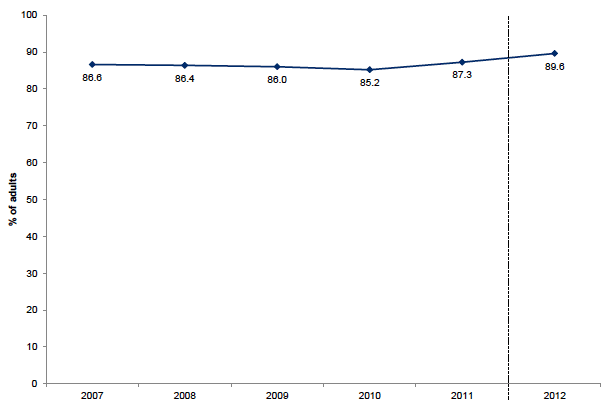
* Note that the figure for 2012 is not directly comparable with previous years due to changes in the wording of the cultural attendance and participation questions.
Attendance at cultural events and places
Attendance at specific cultural events or places
Figure 13.2 shows levels of attendance by adults at specific cultural events and visiting places of culture (not as a result of paid work, school or academic activities) in the last 12 months for 2012.
Figure 13.2: Attendance at cultural events and visiting places of culture in the last 12 months
2012 data, Adults (base: 9,890)
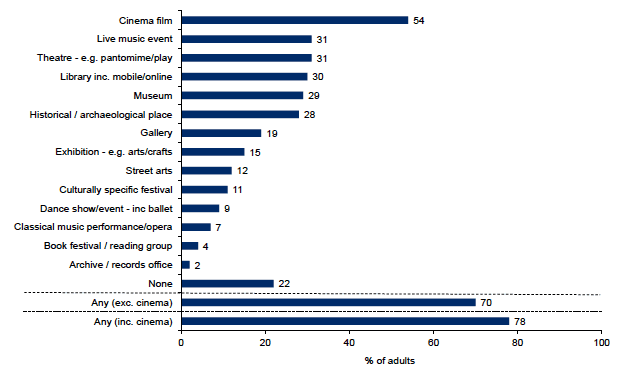
The chart also shows that:
- Almost 8-in-10 adults (78%) attended a cultural event or place of culture in the last 12 months. When excluding cinema, this figure falls slightly to 70%.
- Over half of respondents (54%) viewed a film at a cinema in the last 12 months, making this the most common type of cultural attendance.
- The next most common types of cultural attendance are at live music events and theatres (both 31%), followed by libraries (30%), museums (29%) and historical or archaeological places (28%).
- Attendance at two other types of cultural place is between 15 and 20 per cent. These are galleries (19%) and exhibitions (including arts and crafts) (15%).
- Attendance at other cultural events or places of culture is lower (12 per cent of respondents or less).
- Just over a fifth of adults (22%) did not attend a cultural event or place of culture in the last 12 months.
Attendance by gender and age
Table 13.1 shows levels of attendance at any cultural event or place of culture in the last 12 months by gender and age of respondent for 2012.
Table 13.1: Attendance at cultural events and visiting places of culture in the last 12 months, by gender and age
Column percentages, 2012 data
| Adults | Male | Female | 16 to 24 | 25 to 34 | 35 to 44 | 45 to 59 | 60 to 74 | 75 plus | All |
|---|---|---|---|---|---|---|---|---|---|
| Any cultural attendance (including cinema) | 77 | 80 | 90 | 89 | 85 | 77 | 69 | 51 | 78 |
| Any cultural attendance (excluding cinema) | 67 | 73 | 75 | 77 | 76 | 69 | 67 | 49 | 70 |
| Base | 4,410 | 5,490 | 780 | 1,380 | 1,550 | 2,460 | 2,440 | 1,290 | 9,890 |
More women attend a cultural event than men (80% and 77% respectively). When excluding cinema, the difference between men and women is greater (6 percentage points), although the difference is much less than that for cultural participation. Analysis on cultural participation by gender is presented later in this chapter.
The level of cultural attendance declines with age and decreases considerably for those aged 45 or older. Whilst levels of cultural attendance are 85% or greater for adults aged 16 to 45, the figure falls to 77% for those aged 45 to 59 and to around half (51%) of all adults aged 75 or over. When excluding cinema, the differences in cultural attendance between age groups are much less marked.
Table 13.2 shows how attendance at specific cultural events and visiting places of culture varies by gender and age.
Table 13.2: Attendance at cultural events and visiting places of culture in the last 12 months by gender and age
Percentages, 2012 data
| Adults | Male | Female | 16 to 24 | 25 to 34 | 35 to 44 | 45 to 59 | 60 to 74 | 75 plus | All |
|---|---|---|---|---|---|---|---|---|---|
| Cinema | 52 | 55 | 80 | 75 | 67 | 48 | 30 | 14 | 54 |
| Live music event - e.g. traditional music, rock concert, jazz event (not opera or classical music performance) | 31 | 31 | 46 | 39 | 35 | 31 | 19 | 8 | 31 |
| Theatre - e.g. pantomime / musical / play | 25 | 37 | 25 | 28 | 34 | 35 | 37 | 21 | 31 |
| Library (including mobile and online) | 26 | 34 | 32 | 32 | 34 | 25 | 31 | 26 | 30 |
| Museum | 28 | 30 | 23 | 36 | 37 | 29 | 27 | 14 | 29 |
| Historic place - e.g. castle, stately home and grounds, battle or archaeological site | 28 | 28 | 22 | 31 | 36 | 30 | 27 | 12 | 28 |
| Gallery | 18 | 20 | 16 | 21 | 24 | 20 | 19 | 9 | 19 |
| Exhibition - including art, photography and crafts | 14 | 16 | 12 | 16 | 18 | 17 | 16 | 7 | 15 |
| Street arts (e.g. musical performances or art in parks, streets or shopping centre) | 12 | 12 | 12 | 15 | 16 | 13 | 10 | 2 | 12 |
| Culturally specific festival (e.g. mela /Feis/ local Gala days) | 10 | 11 | 8 | 11 | 16 | 13 | 9 | 3 | 11 |
| Dance show / event - e.g. ballet | 7 | 12 | 10 | 9 | 13 | 10 | 8 | 4 | 9 |
| Classical music performance or opera | 6 | 8 | 5 | 4 | 6 | 8 | 10 | 7 | 7 |
| Book festival or reading group | 3 | 5 | 3 | 4 | 5 | 5 | 5 | 2 | 4 |
| Archive or records office (e.g. Scotland's Family History Peoples Centre) | 2 | 2 | 1 | 1 | 2 | 2 | 3 | 1 | 2 |
| None | 23 | 20 | 10 | 11 | 15 | 23 | 31 | 49 | 22 |
| Base | 4,410 | 5,490 | 780 | 1,380 | 1,550 | 2,460 | 2,440 | 1,290 | 9,890 |
Columns add to more than 100% since multiple responses allowed.
The key points are:
- There are some cultural events or places in which women are more likely to attend or visit than men. The greatest percentage point difference is for attendance at plays, drama or theatrical performances (37% of women compared with 25% of men). Library visits also show considerable differences by gender, with 34% of women and 26% of men reporting that they have visited in the last 12 months.
- There are some cultural events where attendance by men is the same as for women. For instance, both 31% of men and women state that they have attended a live music event in the past year and 28% have visited a historic place.
- Cultural attendance at specific events or places vary by age. Differences between the youngest and oldest age groups are most marked for cinema attendance and for attendance at live music events. Four fifths of 16 to 24 year olds state that they have viewed films at the cinema in the last 12 months, compared with 14% of those aged 75 or greater. Just under half (46%) of 16 to 24 year olds state that they have attended a live music event in the last 12 months. This compares with 19% of 60 to 74 year olds and 8% of those aged 75 or greater.
- For some cultural places, attendance is highest for many of the middle and older age groups. This includes attendance at theatres where between 34% and 37% of 35 to 74 year olds stated they attended, compared with 25% of 16 to 24 year olds and 21% of those aged 75 or greater.
- Attendance at some cultural places appear to show a slightly more uniform pattern across different age groups. This includes visits to libraries, in which attendance figures were very similar for all groups apart from those aged 45 to 59 and those aged 75 or greater.
Attendance by highest level of qualification
Figure 13.3 shows that in 2012, attendance at cultural places and visiting places of culture is highest for those with degrees or professional qualifications (93%). Attendance is lowest for those with no qualifications (50%). The percentage of adults who attended any cultural event or place (excluding cinema) shows a similar picture; 88% for those with degrees or professional qualifications and 44% for those with no qualifications.
Figure 13.3: Attendance at cultural events and visiting places of culture in the last 12 months by highest level of qualification
2012 data, Adults (base: 9,890)
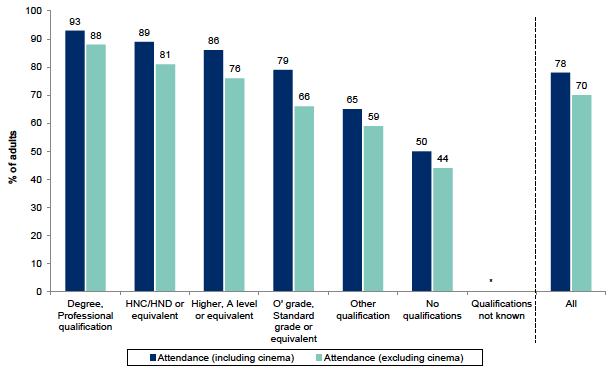
Table 13.3 shows that in 2012, attendance at each individual cultural event or place is consistently highest for adults with a degree or professional qualification. Attendance at different types of cultural event or place is usually lowest among adults with no qualifications. This may be because there are a large percentage of people interviewed in the survey who are aged 60 and over with no qualifications.
Table 13.3: Attendance at cultural events and visiting places of culture in the last 12 months by highest qualification level
Percentages, 2012 data
| Adults | Degree, Professi- onal qualific- ation |
HNC/HND or equivalent | Higher, A level or equivalent | O' Grade, Standard grade or equivalent | Other qualific- ation |
No qualific- ations |
Qualific- ations not known |
All |
|---|---|---|---|---|---|---|---|---|
| Cinema | 71 | 67 | 64 | 55 | 25 | 21 | * | 54 |
| Live music event - e.g. traditional music, rock concert, jazz event (not opera or classical music performance) | 44 | 41 | 39 | 26 | 12 | 9 | * | 31 |
| Theatre - e.g. pantomime / musical / play | 47 | 37 | 31 | 23 | 27 | 17 | * | 31 |
| Library (including mobile and online) | 40 | 33 | 32 | 25 | 25 | 18 | * | 30 |
| Museum | 48 | 33 | 30 | 20 | 16 | 12 | * | 29 |
| Historic place - e.g. castle, stately home and grounds, battle or archaeological site | 51 | 35 | 26 | 18 | 15 | 9 | * | 28 |
| Gallery | 37 | 21 | 20 | 10 | 8 | 6 | * | 19 |
| Exhibition - including art, photography and crafts | 32 | 18 | 15 | 6 | 6 | 3 | * | 15 |
| Street arts (e.g. musical performances or art in parks, streets or shopping centre) | 21 | 15 | 13 | 8 | 5 | 4 | * | 12 |
| Culturally specific festival (e.g. mela /Feis/ local Gala days) | 20 | 12 | 10 | 6 | 5 | 3 | * | 11 |
| Dance show / event - e.g. ballet | 16 | 12 | 9 | 8 | 5 | 3 | * | 9 |
| Classical music performance or opera | 17 | 6 | 5 | 3 | 4 | 1 | * | 7 |
| Book festival or reading group | 10 | 3 | 4 | 1 | 0 | 1 | * | 4 |
| Archive or records office (e.g. Scotland's Family History Peoples Centre) | 3 | 2 | 2 | 1 | 1 | 0 | * | 2 |
| None | 7 | 11 | 14 | 21 | 35 | 50 | * | 22 |
| Base | 2,600 | 1,000 | 1,530 | 1,770 | 480 | 2,460 | 60 | 9,890 |
Attendance by area deprivation
Figure 13.4 shows that levels of cultural attendance varies with the area deprivation that respondents live in. Respondents living in more deprived areas are the least likely to visit a cultural place or event in 2012. There is an 18 percentage point difference in cultural attendance by adults between the most and least deprived areas (70% compared with 88%). When excluding cinema, the differences are slightly more pronounced (60% in the most deprived areas and 83% in the least deprived areas).
Figure 13.4: Attendance at cultural events and visiting places of culture in the last 12 months by Scottish Index of Multiple Deprivation
2012 data, Adults (base: 9,890)
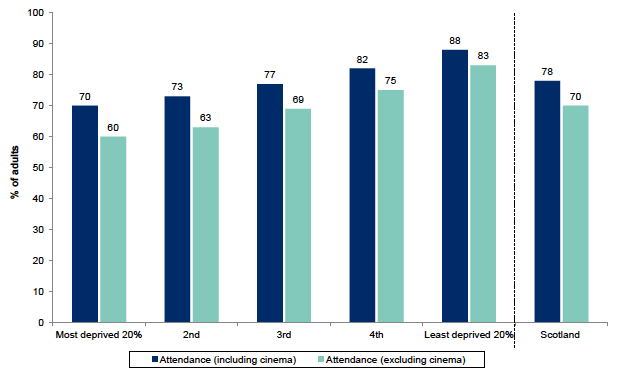
Attendance by long-standing illness, health problem or disability
Figure 13.5 shows that those with either a disability, illness or health problem, or both, are much less likely to attend a cultural event than those without. The same pattern exists when considering cultural attendance (excluding cinema), although the difference is smaller.
Figure 13.5: Attendance at cultural events and visiting places of culture in the last 12 months by long-standing illness, health problem or disability
2012 data, Adults (base: 6,680)
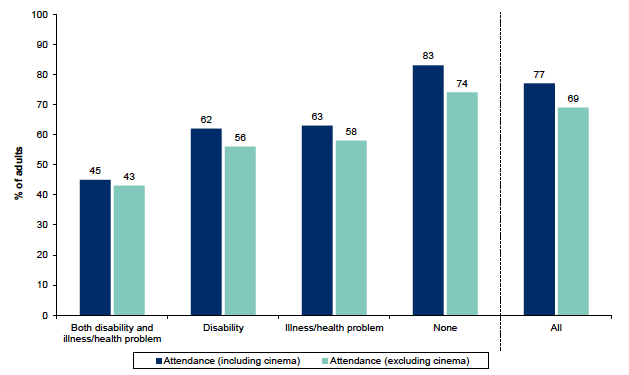
This question was asked in the survey from January to September 2012
Frequency of attending cultural events or places
Table 13.4 provides more information on how regularly those who attended particular cultural events or visited places of culture had done so in the past year. The table shows that libraries are by far the most frequently visited cultural place or event. Of those that visited a library, around one in five (20%) visited a library at least once a week in the past year. A further 41% of respondents visited at least once a month. For comparison, of those who visited a cinema, 4% attended once a week and around a quarter (24%) attended at least once a month. Visits to other cultural events or places in the past 12 months were far less frequent.
Table 13.4: Frequency of attending cultural events and visiting places of culture in the last 12 months
Row percentages, 2012 data
| Adults | At least once a week | Less often than once a week / at least once a month | Less often than once a month / at least 3-4 times a year | Twice in the last 12 months | Once in the last 12 months | Don't know | Total | Base |
|---|---|---|---|---|---|---|---|---|
| Cinema | 4 | 24 | 42 | 22 | 8 | 0 | 100 | 4,620 |
| Live music event - e.g. traditional music, rock concert, jazz event (not opera or classical music performance) | 1 | 10 | 33 | 32 | 23 | 0 | 100 | 2,770 |
| Theatre - e.g. pantomime / musical / play | 0 | 5 | 25 | 39 | 31 | 0 | 100 | 2,940 |
| Library (including mobile and online) | 20 | 41 | 20 | 14 | 6 | 0 | 100 | 3,010 |
| Museum | 1 | 10 | 27 | 36 | 26 | 0 | 100 | 2,810 |
| Historic place - e.g. castle, stately home and grounds, battle or archaeological site | 1 | 9 | 32 | 36 | 22 | 0 | 100 | 2,620 |
| Gallery | 1 | 11 | 29 | 33 | 25 | 0 | 100 | 1,810 |
| Exhibition - including art, photography and crafts | 1 | 9 | 27 | 32 | 31 | 0 | 100 | 1,540 |
| Street arts (e.g. musical performances or art in parks, streets or shopping centre) | 1 | 4 | 18 | 33 | 44 | 0 | 100 | 1,090 |
| Culturally specific festival (e.g. mela /Feis/ local Gala days) | 0 | 2 | 15 | 32 | 51 | 0 | 100 | 1,070 |
| Dance show / event - e.g. ballet | 1 | 3 | 15 | 29 | 51 | 1 | 100 | 890 |
| Classical music performance or opera | 1 | 9 | 29 | 29 | 30 | 1 | 100 | 740 |
| Book festival or reading group | 3 | 10 | 8 | 19 | 60 | 1 | 100 | 410 |
| Archive or records office (e.g. Scotland's Family History Peoples Centre) | 1 | 7 | 16 | 16 | 57 | 2 | 100 | 210 |
Participation in Cultural activities
This section contains data on the percentage of adults who participated in a cultural activity in the last 12 months in 2012, as well as participation in specific activities over this time period. Data for 2012 are presented on cultural participation for a number of socio-economic indicators. These include gender, age, highest level of qualification, area deprivation and long-standing illness, health problem or disability.
Data are also provided on the frequency in which those who have participated in culture have done so in the past 12 months.
Participation in specific cultural activities
Figure 13.6 shows levels of cultural participation in specific activities by adults in the last 12 months for 2012. The chart shows that:
- Reading for pleasure is by far the most common cultural activity in 2012 with 69% of adults saying that they have done this in the last year.
- The next most popular activity is doing creative work on a computer or by social media (23%), followed by crafts (14%), dancing (12%), playing and writing music (11%).
- Participation levels in all other cultural activities is 10% or less.
- Over a fifth of adults did not participate in any cultural activity in the past year (22%). Participation in a cultural activity in the last 12 months was 78%; the percentage who participated in a cultural activity (excluding reading) was much lower at 48%.
Figure 13.6: Participation in cultural activities in the last 12 months
2012 data, Adults (base: 9,890)
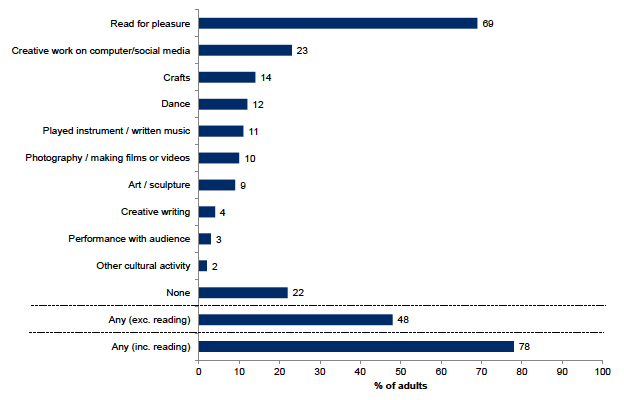
Participation by gender and age
Table 13.5 shows levels of participation in any cultural activity in the last 12 months by gender and age of respondent for 2012.
Table 13.5: Participation in any cultural activity in the last 12 months by gender and age
Column percentages, 2012 data
| Adults | Male | Female | 16 to 24 | 25 to 34 | 35 to 44 | 45 to 59 | 60 to 74 | 75 plus | All |
|---|---|---|---|---|---|---|---|---|---|
| Participated in any (including reading) | 73 | 84 | 79 | 81 | 79 | 78 | 79 | 71 | 78 |
| Participated in any (excluding reading) | 44 | 51 | 62 | 54 | 49 | 45 | 44 | 30 | 48 |
| Base | 4,410 | 5,490 | 780 | 1,380 | 1,550 | 2,460 | 2,440 | 1,290 | 9,890 |
It can be seen that:
- More women participate in a cultural activity than men (84% and 73% respectively). When excluding reading, the difference between women and men is much less (51% and 44% respectively).
- Levels of cultural participation are broadly constant for those aged 16 to 74 (between 78% and 81%) whilst participation levels are lower for those aged 75 or over (71%). The differences between age groups are much more marked when considering cultural participation excluding reading (from 62% of adults aged 16 to 24 to 30% of adults aged 75 or greater).
Table 13.6 shows how participation in specific cultural activities vary by age and gender. The key points are:
- Overall cultural participation is higher for women than men, but there are specific activities in which participation by men is greater.
- Women participate more than men in a number of cultural activities including reading for pleasure (77% compared with 61%), crafts (22% compared with 6%) and in dancing (15% compared with 9%).
- Participation in some activities is higher for men than women. This includes playing a musical instrument or writing music (14% of men, 8% of women) and using a computer or social media to produce creative work of any kind (25% compared with 21%).
- Participation in some but not all cultural activities decreases with increasing age of respondent. For instance, 35% of 16 to 24 year olds and 31% of 25 to 34 year olds used a computer or social media to produce creative work of any kind. This compares with 15% of 60 to 74 year olds and 4% of those aged 75 or older. Participation in dance is most popular for younger age groups (15% of 16 to 24 year olds compared with 6% for those aged 75 or above).
- Reading for pleasure shows little difference with age, although it is a less popular activity amongst 16 to 24 year olds (62% compared with 69% for all adults across Scotland).
- Participation in crafts increases by age from 7% of 16 to 24 year olds to 22% of 60 to 74 year olds before falling again in over 75 year olds.
Table 13.6: Participation in cultural activities in the last 12 months by gender and age
Percentages, 2012 data
| Adults | Male | Female | 16 to 24 | 25 to 34 | 35 to 44 | 45 to 59 | 60 to 74 | 75 plus | All |
|---|---|---|---|---|---|---|---|---|---|
| Read for pleasure (not newspapers, magazines or comics) | 61 | 77 | 62 | 69 | 71 | 70 | 72 | 66 | 69 |
| Used a computer / social media to produce creative work of any kind | 25 | 21 | 35 | 31 | 27 | 21 | 15 | 4 | 23 |
| Crafts such as knitting, wood, pottery, etc. | 6 | 22 | 7 | 11 | 11 | 16 | 22 | 17 | 14 |
| Dance - e.g. ceilidh, salsa, Highland dancing, ballet | 9 | 15 | 15 | 14 | 13 | 13 | 10 | 6 | 12 |
| Played a musical instrument or written music | 14 | 8 | 23 | 14 | 12 | 8 | 6 | 4 | 11 |
| Photography / making films or videos as an artistic activity (not family or holiday 'snaps') | 11 | 9 | 12 | 13 | 10 | 10 | 9 | 3 | 10 |
| Painting, drawing, printmaking or sculpture | 8 | 11 | 18 | 13 | 11 | 7 | 6 | 3 | 9 |
| Creative writing - stories, books, plays or poetry | 4 | 5 | 8 | 6 | 4 | 4 | 3 | 1 | 4 |
| Took part in a play / sang in a choir or other performance (not karaoke) | 2 | 4 | 7 | 3 | 2 | 3 | 3 | 1 | 3 |
| Other cultural activity | 2 | 2 | 3 | 3 | 2 | 2 | 2 | 2 | 2 |
| None | 27 | 16 | 21 | 19 | 21 | 22 | 21 | 29 | 22 |
| Base | 4,410 | 5,490 | 780 | 1,380 | 1,550 | 2,460 | 2,440 | 1,290 | 9,890 |
Columns add to more than 100% since multiple responses allowed.
Participation by highest level of qualification
Figure 13.7 shows that participation in any cultural activity in 2012 is highest amongst adults with a degree or professional qualifications (94%) and lowest for those with no qualifications (58%). A similar picture can be seen when looking at the percentage of adults who participated in a cultural activity other than reading, although the difference between qualification levels is even greater.
Table 13.7 shows that participation in specific cultural activities in 2012 is nearly always highest for those with a degree or professional qualification. The percentage of adults with no qualifications who read for pleasure is much higher than for other cultural activity. This may be because there are a large percentage of people interviewed in the survey who are aged 60 and over with no qualifications.
Figure 13.7: Participation in any cultural activity in the last 12 months by highest level of qualification
2012 data, Adults (base: 9,890)
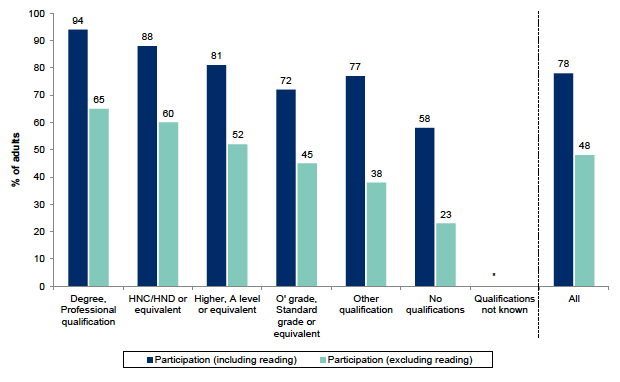
Table 13.7: Participation in cultural activities in the last 12 months by highest level of qualification
Percentages, 2012 data
| Adults | Degree, Professional qualification | HNC/HND or equivalent | Higher, A level or equivalent | O' Grade, Standard grade or equivalent | Other qualification | No qualifications | Qualifications not known | All |
|---|---|---|---|---|---|---|---|---|
| Read for pleasure (not newspapers, magazines or comics) | 89 | 75 | 70 | 59 | 69 | 50 | * | 69 |
| Used a computer / social media to produce creative work of any kind | 33 | 33 | 27 | 22 | 8 | 5 | * | 23 |
| Crafts such as knitting, wood, pottery, etc. | 20 | 15 | 13 | 11 | 19 | 10 | * | 14 |
| Dance - e.g. ceilidh, salsa, Highland dancing, ballet | 20 | 12 | 13 | 10 | 6 | 5 | * | 12 |
| Played a musical instrument or written music | 16 | 13 | 15 | 10 | 3 | 3 | * | 11 |
| Photography / making films or videos as an artistic activity (not family or holiday 'snaps') | 18 | 13 | 11 | 6 | 4 | 2 | * | 10 |
| Painting, drawing, printmaking or sculpture | 12 | 14 | 13 | 9 | 5 | 3 | * | 9 |
| Creative writing - stories, books, plays or poetry | 7 | 5 | 5 | 3 | 1 | 1 | * | 4 |
| Took part in a play / sang in a choir or other performance (not karaoke) | 6 | 4 | 4 | 2 | 1 | 1 | * | 3 |
| Other cultural activity | 5 | 3 | 1 | 1 | 1 | 1 | * | 2 |
| None | 6 | 12 | 19 | 28 | 23 | 42 | * | 22 |
| Base | 2,600 | 1,000 | 1,530 | 1,770 | 480 | 2,460 | 60 | 9,890 |
Columns add to more than 100% since multiple responses allowed.
Participation by area deprivation
Figure 13.8 shows that adult cultural participation varies with the area deprivation that respondents live in. Respondents living in more deprived areas participate less in any cultural activity - there is nearly a 20 percentage point difference in cultural participation between the most and least deprived areas. The percentage of adults who participated in a cultural activity other than reading in the past 12 months shows a similar pattern with area deprivation that respondents live in.
Figure 13.8: Participation in any cultural activity in the last 12 months by Scottish Index of Multiple Deprivation
2012 data, Adults (base: 9,890)
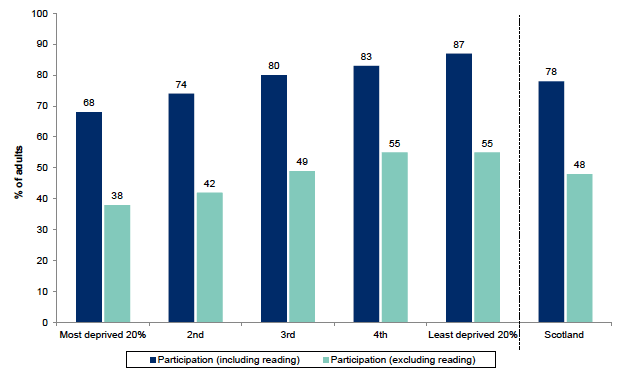
Participation by long-standing illness, health problem or disability
Figure 13.9 shows that those with a disability (73%), or illness or health problem (74%) are less likely to participate than those without (81%). It also shows that those who have both a disability and a long-term illness are the least likely to participate in any cultural activity (60%). The picture is more marked when considering any cultural participation other than reading, with 23% of those who have both a disability and long-term illness participating, compared with 50% with neither a disability or long-term illness.
Figure 13.9: Participation in any cultural activity in the last 12 months by long-standing illness, health problem or disability
2012 data, Adults (base: 6,680)
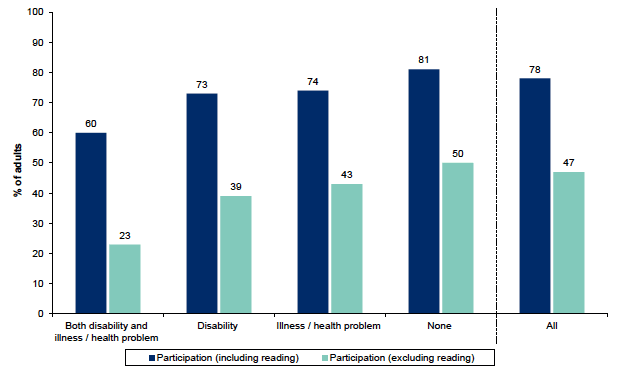
Note that this question was asked in the survey from January to September 2012
Frequency of participating in cultural activities
Table 13.8 shows that reading for pleasure is the cultural activity which respondents most frequently participated in. Of those that read for pleasure in the last year, 82% state that they read at least once a week with a further 10% saying that they had read at least once a month. Using a computer or social media for creative work was also frequent amongst participants, with 64% of those who participated having done so at least once a week. Around six-in-ten (59%) of those who played a musical instrument or wrote music did so at least once a week. The general pattern for many other cultural activities is that although a relatively small proportion of adults participated in them, those that did participate often did so frequently (at least once a month). This contrasts with attendance at many cultural events or places, where a higher proportion of adults attended, albeit less frequently.
Table 13.8: Frequency of participating in cultural activities in the last 12 months
Row percentages, 2012 data
| Adults | At least once a week | Less often than once a week / at least once a month | Less often than once a month / at least 3-4 times a year | Twice in the last 12 months | Once in the last 12 months | Don't know | Total | Base |
|---|---|---|---|---|---|---|---|---|
| Read for pleasure (not newspapers, magazines or comics) | 82 | 10 | 5 | 2 | 1 | 0 | 100 | 6,880 |
| Used a computer / social media to produce creative work of any kind | 64 | 16 | 11 | 6 | 3 | 0 | 100 | 2,000 |
| Crafts such as knitting, wood, pottery, etc. | 53 | 23 | 15 | 7 | 2 | 0 | 100 | 1,660 |
| Dance - e.g. ceilidh, salsa, Highland dancing, ballet | 24 | 19 | 27 | 20 | 10 | 0 | 100 | 1,160 |
| Played a musical instrument or written music | 59 | 23 | 12 | 5 | 2 | 0 | 100 | 970 |
| Photography / making films or videos as an artistic activity (not family or holiday 'snaps') | 35 | 33 | 22 | 7 | 3 | 1 | 100 | 950 |
| Painting, drawing, printmaking or sculpture | 44 | 26 | 19 | 9 | 2 | 1 | 100 | 870 |
| Creative writing - stories, books, plays or poetry | 41 | 29 | 19 | 7 | 4 | 0 | 100 | 400 |
| Took part in a play / sang in a choir or other performance (not karaoke) | 37 | 16 | 18 | 15 | 14 | 0 | 100 | 320 |
| Other cultural activity | 37 | 17 | 22 | 12 | 10 | 1 | 100 | 220 |
Participation in Sport
This section contains data on the percentage of adults who participated in a sport in the previous four weeks in 2012, as well as participation in specific sports over this time period. The Glossary in Annex 2 provides a complete list of activities which are included in the Sport question in the SHS. In some cases, information is provided for each of the years from 2007 to 2012 and figures are presented by age, gender, area deprivation and whether respondents have a long-standing illness, health problem or disability. Results are presented which show how frequently adults participate in sports in each of the years from 2007 to 2012. The report also provides some key messages on people's levels of satisfaction with local authority local authority sports and leisure facilities.
Participation in specific sports in the last four weeks
Figure 13.10 shows the percentage of adults who participated in sports in the previous four weeks in 2012. Around three quarters of adults (74%) had participated in any sport in the last four weeks. By far the most prevalent activity was walking for 30 minutes (for recreational purposes). Almost six-in-ten adults (59%) had done this in the last four weeks compared with fewer than one in five undertaking any other individual activity. When walking was excluded, just over half of adults (51%) had undertaken at least one of the remaining sports in the four weeks.
Figure 13.10: Participation in sport in the last four weeks
2012 data, Adults (base: 9,890)
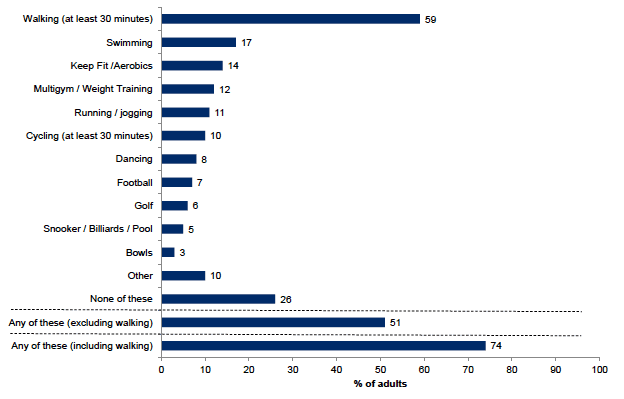
Figure 13.11 shows the participation figures for sport amongst all adults in each year from 2007 to 2012. The percentage of adults who participated in any sport in the previous four weeks has remained broadly constant between 2007 and 2010 at between 72% and 73%, although it is slightly higher in 2011 (75%) and 2012 (74%). When excluding walking, the sports participation figures have remained broadly constant between 2007 and 2012, but were slightly higher in 2011. The percentage of adults who walked for more than 30 minutes at a time in the last four weeks has seen an increase from 54% in 2010 to 59% in 2012.
Participation in sports - trends over time
Figure 13.11: Participation in sport in the last four weeks
Percentages, 2007 to 2012 data
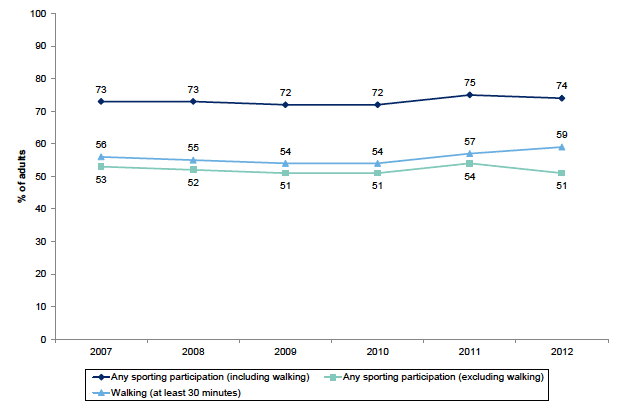
Table 13.9 shows there has been little difference in the percentage of adults who participate in many sports activities between 2007 and 2012, although there has been a fall in the percentage of adults who danced in the past four weeks, from 14% in 2007 to 8% in 2012 and a slight fall in those who played golf over this time period, from 9% to 6%. There is a trend in the last six years of increasing frequency of participation amongst those who do take part in sport and this will be explored later in the chapter.
Table 13.9: Participation in sport in the last four weeks
Percentages 2007 to 2012 data
| Adults | 2007 | 2008 | 2009 | 2010 | 2011 | 2012 |
|---|---|---|---|---|---|---|
| Any sporting participation (including walking) | 73 | 73 | 72 | 72 | 75 | 74 |
| Any sporting participation (excluding walking) | 53 | 52 | 51 | 51 | 54 | 51 |
| Walking (at least 30 minutes) | 56 | 55 | 54 | 54 | 57 | 59 |
| Swimming | 19 | 19 | 17 | 17 | 18 | 17 |
| Keep Fit /Aerobics | 12 | 12 | 12 | 13 | 14 | 14 |
| Multigym / Weight Training | 11 | 11 | 11 | 11 | 12 | 12 |
| Running / jogging | 10 | 9 | 10 | 10 | 11 | 11 |
| Cycling (at least 30 minutes) | 9 | 9 | 9 | 9 | 10 | 10 |
| Dancing | 14 | 12 | 11 | 10 | 10 | 8 |
| Football | 9 | 8 | 9 | 9 | 8 | 7 |
| Golf | 9 | 8 | 8 | 7 | 8 | 6 |
| Snooker / Billiards / Pool | 9 | 9 | 8 | 7 | 7 | 5 |
| Bowls | 4 | 4 | 3 | 3 | 3 | 3 |
| Other | 9 | 10 | 6 | 8 | 10 | 10 |
| None of these | 27 | 27 | 28 | 28 | 25 | 26 |
| Base | 10,300 | 9,230 | 9,130 | 9,620 | 9,680 | 9,890 |
Figure 13.12: Participation in sport in the last four weeks, by age
Percentages, 2007 to 2012 data
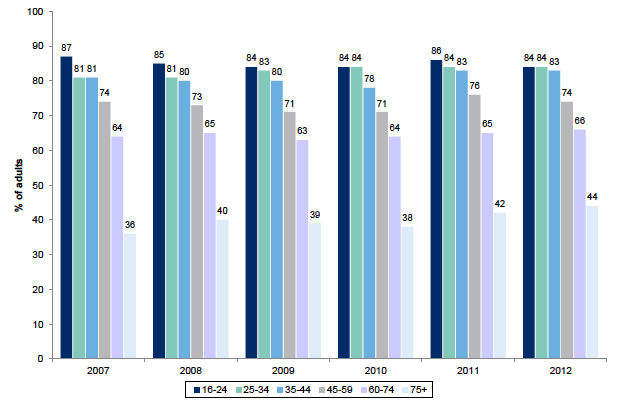
Figure 13.12 shows how sports participation in the previous four weeks has changed amongst different age groups from 2007 to 2012. Sports participation decreases with age, with around 83% to 84% of adults aged between 16 to 44 participating in a sport in the previous four weeks in 2012. This figure falls to 74% for those aged between 45 and 59 and to 66% for those aged between 60 to 74 respectively. It falls more sharply to 44% of those aged 75 or greater.
The differences between age groups are not as large as in 2007, although for some age groups there is no clear trend in levels of participation in any sport over time, with fluctuations between years. However, there has been an increase in participation in sports for those aged 75 or greater, from 36% in 2007 to 44% in 2012.
Figure 13.13: Participation in any sport (excluding walking) in the last four weeks, by age
Percentages, 2007 to 2012 data
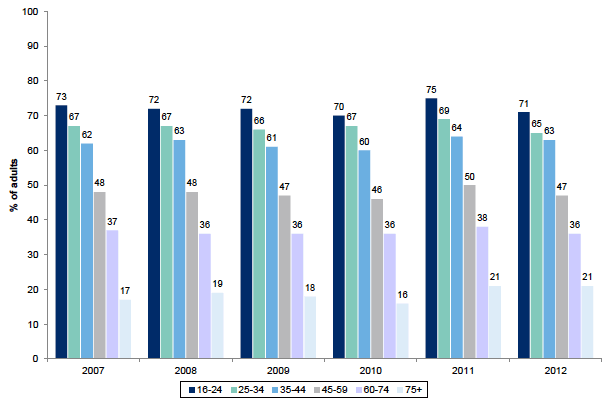
Figure 13.13 shows how the age breakdown of adults who participated in any sports other than walking in the previous four weeks has changed over time from 2007 to 2012. When excluding walking as a sporting activity, a similar pattern can be found as for all sports participation, but the differences between age groups is greater, with the middle and older age groups participating far less than younger age groups. For instance, in 2012, 47% of adults aged 45 to 59 participated in a sport other than walking in the previous four weeks, compared with 74% for all sports. There is very little difference in participation levels in many age groups over time although there has been an increase in those aged 75 or older (from 17% in 2007 to 21% in 2012).
Figure 13.14: Participation in walking in the last four weeks, by age
Percentages, 2007 to 2012 data
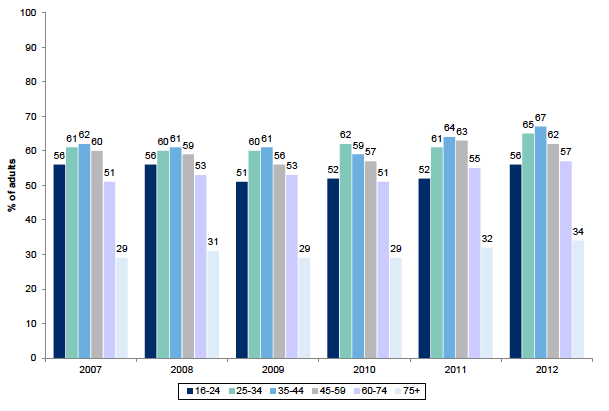
Figure 13.14 shows how the age breakdown of adults who participated in walking in the previous four weeks has changed over time from 2007 to 2012. The percentage of adults who walked more than 30 minutes at a time in the previous four weeks shows a more uniform pattern amongst many age groups than for participation figures for any sports. In 2012, walking was most popular amongst those aged 35 to 44 (67%), followed by those aged 25 to 34 (65%) and 45 to 59 year olds (62%). There has been an increase from 2010 to 2012 in the proportion of adults who walked for pleasure in the previous four weeks across all age groups.
Participation in specific sports by gender and age
Table 13.10 presents results on sports participation in the past four weeks by age and gender for 2012. The main points are:
- Overall sports participation is higher for men than women (77% and 72% respectively). This difference is larger when walking is excluded, with 57% of men and 46% of women participating in a sport other than walking.
- There are a number of specific sports in which participation by women is greater. Walking for at least 30 minutes is the most popular form of sport for both men and women and it is more popular amongst women (60%, compared with 57% of men). Swimming, keep fit/aerobics and dancing are all more popular amongst women compared with men.
- Participation in many other sports and activities is higher amongst men than women. These include football, multigym and weight training and golf.
- Some of the sports activities listed below are most popular with younger adults. Playing football is particularly associated with age, with 20% of people aged 16 to 24 participating in the previous four weeks, compared with 4% of 45 to 59 year olds. Some sports such as swimming and cycling show much less of a pattern of with age and are most popular amongst adults aged 35 to 44 (26% and 16% respectively).
Table 13.10: Participation in sports in the past four weeks by gender and age
Percentages, 2012 data
| Adults | Male | Female | 16 to 24 | 25 to 34 | 35 to 44 | 45 to 59 | 60 to 74 | 75 plus | All |
|---|---|---|---|---|---|---|---|---|---|
| Any sporting participation (including walking) | 77 | 72 | 84 | 84 | 83 | 74 | 66 | 44 | 74 |
| Any sporting participation (excluding walking) | 57 | 46 | 71 | 65 | 63 | 47 | 36 | 21 | 51 |
| Walking (at least 30 minutes) | 57 | 60 | 56 | 65 | 67 | 62 | 57 | 34 | 59 |
| Swimming | 15 | 19 | 22 | 24 | 26 | 14 | 10 | 3 | 17 |
| Keep Fit /Aerobics | 10 | 18 | 20 | 19 | 18 | 12 | 9 | 5 | 14 |
| Multigym / Weight Training | 16 | 8 | 24 | 18 | 14 | 9 | 4 | 1 | 12 |
| Running / jogging | 13 | 9 | 24 | 19 | 16 | 7 | 2 | 0 | 11 |
| Cycling (at least 30 minutes) | 14 | 6 | 11 | 13 | 16 | 10 | 4 | 1 | 10 |
| Dancing | 4 | 11 | 11 | 9 | 7 | 7 | 6 | 4 | 8 |
| Football | 15 | 1 | 20 | 13 | 8 | 4 | 0 | . | 7 |
| Golf | 11 | 2 | 6 | 6 | 6 | 7 | 8 | 4 | 6 |
| Snooker / Billiards / Pool | 10 | 2 | 11 | 9 | 6 | 4 | 2 | 1 | 5 |
| Bowls | 3 | 2 | 2 | 2 | 1 | 2 | 4 | 6 | 3 |
| Other | 12 | 7 | 15 | 13 | 10 | 9 | 6 | 2 | 10 |
| None of these | 23 | 28 | 16 | 16 | 17 | 26 | 34 | 56 | 26 |
| Base | 4,410 | 5,490 | 780 | 1,380 | 1,550 | 2,460 | 2,440 | 1,290 | 9,890 |
Participation in sports by area deprivation
In 2012, participation by adults in any sport (including walking) in the previous four weeks varied according to the area deprivation that respondents live in (65% of those in the most deprived areas compared with 81% in the least deprived areas). Variation in levels of sports participation with area deprivation is greater when walking is excluded (40% in the most deprived areas, compared with 62% in the least deprived areas).
Figure 13.15: Participation in Sport in the last four weeks by Scottish Index of Multiple Deprivation
2012 data, Adults (base: 9,890)
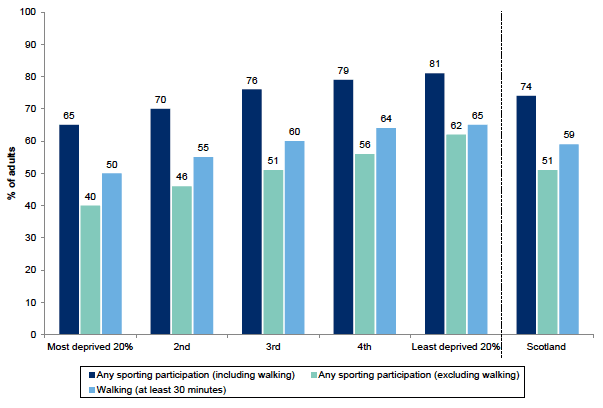
Participation in sports by long-standing illness, health problem or disability
Figure 13.16 shows that those with a disability (47%), or illness or health problem (56%) are less likely to participate in any sports than those without (82%). It also shows that those who have both a disability and a long-term illness are the least likely to participate in a sporting activity (40%). When excluding walking as an activity, 30% of those with a disability or with an illness or health problem participated in a sport in the previous four weeks. This compares with 20% of adults with both an illness or disability and 59% with neither. Walking rates are lowest amongst adults with a disability (31%, compared with 46% with an illness or health problem).
Figure 13.16: Participation in sport in the last four weeks, by long-standing illness, health problem or disability
2012 data, Adults (base: 6,680)
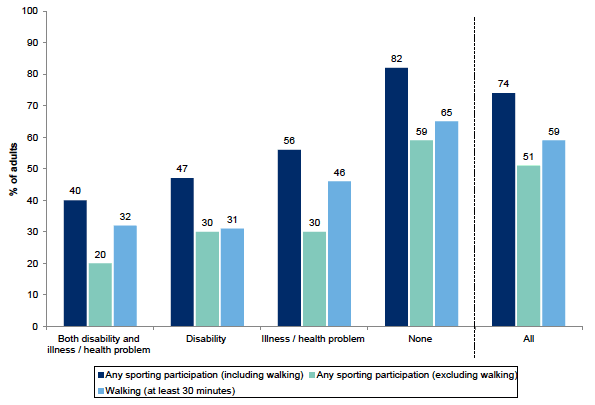
This question was asked in the survey from January to September 2012
Frequency of participation in sports - trends over time
Figure 13.17 shows how the frequency of participation has changed over time of those who took in sport over the previous four weeks. In general, there has been a gradual increase in the frequency of those who participated between 2007 and 2012. In 2007, 23% of participants took part in sport on 22 to 28 days in the four weeks prior to interview. By 2012, this had increased to 28%. In contrast, the percentage of participants who took part in sport less frequently has fallen over this time period. In 2007, 41% of participants took part in sport infrequently (on between 1 and 7 days on the four weeks prior to interview). By 2012, this figure had fallen to 31% of participants.
Figure 13.17: Frequency of participation by adults who took part in sport in the previous four weeks
Percentages, 2007-2012 data
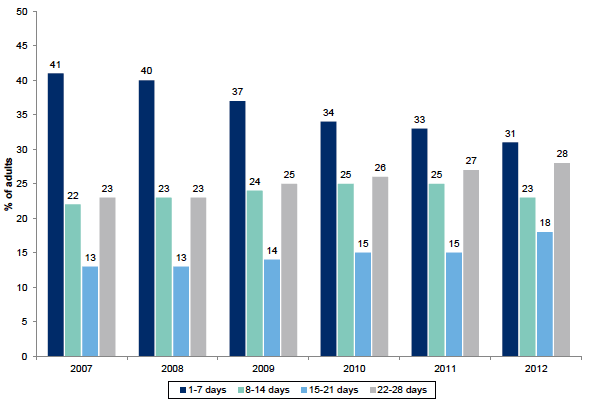
Satisfaction with local authority cultural AND sports services
Since 2007, questions have been asked in the Local Services suite of questions in the SHS on the frequency of use and satisfaction with local authority cultural and sport and leisure services. In particular, data are available on how frequently people use council run sport and leisure facilities, libraries, museums and galleries and theatres and concert halls and on how satisfied they are with each of these services.
Table 13.11 provides data on levels of satisfaction with local authority cultural and sport and leisure services from 2007 to 2012. Of the four services, respondents (including non-users) are most satisfied with sports and leisure facilities and libraries (around 50% of all respondents are very or fairly satisfied). Levels of satisfaction with museums and galleries amongst all respondents varied between 38% and 44% in each of the years between 2007 and 2012. The percentage of respondents with no opinion on each of these services has increased over this time period.
Table 13.11: Satisfaction with local authority culture and sport and leisure services. All people
Column percentages, 2007 to 2012 data
| Adults | 2007 | 2008 | 2009 | 2010 | 2011 | 2012 |
|---|---|---|---|---|---|---|
| Sports and leisure facilities | ||||||
| Very/fairly satisfied | 50 | 50 | 48 | 49 | 51 | 51 |
| Neither satisfied or dissatisfied | 11 | 9 | 9 | 9 | 9 | 7 |
| Very/fairly dissatisfied | 9 | 8 | 8 | 8 | 8 | 5 |
| No opinion | 30 | 32 | 35 | 35 | 33 | 36 |
| Libraries | ||||||
| Very/fairly satisfied | 55 | 55 | 53 | 52 | 52 | 50 |
| Neither satisfied or dissatisfied | 10 | 8 | 7 | 8 | 8 | 8 |
| Very/fairly dissatisfied | 3 | 2 | 2 | 3 | 2 | 2 |
| No opinion | 32 | 34 | 37 | 38 | 37 | 39 |
| Museums and galleries | ||||||
| Very/fairly satisfied | 41 | 42 | 41 | 38 | 44 | 42 |
| Neither satisfied or dissatisfied | 14 | 12 | 10 | 11 | 10 | 10 |
| Very/fairly dissatisfied | 4 | 3 | 3 | 2 | 2 | 2 |
| No opinion | 41 | 42 | 45 | 48 | 44 | 46 |
| Theatres or concert halls | ||||||
| Very/fairly satisfied | 44 | 44 | 43 | 42 | 45 | 44 |
| Neither satisfied or dissatisfied | 14 | 11 | 10 | 10 | 10 | 9 |
| Very/fairly dissatisfied | 5 | 4 | 4 | 3 | 3 | 2 |
| No opinion | 38 | 40 | 43 | 45 | 42 | 45 |
| Base | 10,220 | 9,240 | 9,710 | 9,020 | 9,660 | 9,890 |
Table 13.12 shows levels of satisfaction in local authority culture and sport and leisure services, amongst adults who have used these services in the past year. In 2012, the percentage of respondents who were very or fairly satisfied with each of the four services ranged from 88% for sports and leisure facilities to 93% for libraries. Satisfaction levels amongst service users in the past year have increased for all of the four services. The percentage of respondents who were very or fairly dissatisfied with sports and leisure facilities is slightly higher than for other services in 2012 (7% compared with 2% for other services), although levels have fallen slightly from 2007, when 10% of service users were very or slightly dissatisfied.
Table 13.12: Satisfaction with local authority culture and sport and leisure services. Service users within the past year only
Column percentages, 2007 to 2012 data
| Adults | 2007 | 2008 | 2009 | 2010 | 2011 | 2012 |
|---|---|---|---|---|---|---|
| Sports and leisure facilities | ||||||
| Very/fairly satisfied | 82 | 83 | 82 | 82 | 85 | 88 |
| Neither satisfied or dissatisfied | 7 | 6 | 6 | 6 | 5 | 5 |
| Very/fairly dissatisfied | 10 | 9 | 10 | 9 | 8 | 7 |
| No opinion | 1 | 1 | 1 | 2 | 2 | 1 |
| Base | 3,650 | 3,210 | 3,270 | 3,140 | 3,230 | 3,400 |
| Libraries | ||||||
| Very/fairly satisfied | 90 | 92 | 92 | 91 | 92 | 93 |
| Neither satisfied or dissatisfied | 5 | 4 | 4 | 4 | 4 | 3 |
| Very/fairly dissatisfied | 3 | 3 | 3 | 4 | 2 | 2 |
| No opinion | 2 | 1 | 1 | 2 | 2 | 2 |
| Base | 4,090 | 3,510 | 3,590 | 3,400 | 3,510 | 3,450 |
| Museums and galleries | ||||||
| Very/fairly satisfied | 87 | 89 | 88 | 87 | 90 | 92 |
| Neither satisfied or dissatisfied | 8 | 7 | 6 | 7 | 5 | 3 |
| Very/fairly dissatisfied | 2 | 2 | 3 | 2 | 1 | 2 |
| No opinion | 3 | 2 | 4 | 4 | 4 | 3 |
| Base | 2,870 | 2,630 | 2,720 | 2,460 | 2,830 | 2,800 |
| Theatres or concert halls | ||||||
| Very/fairly satisfied | 86 | 87 | 88 | 88 | 89 | 90 |
| Neither satisfied or dissatisfied | 8 | 6 | 6 | 6 | 5 | 5 |
| Very/fairly dissatisfied | 3 | 4 | 3 | 3 | 3 | 2 |
| No opinion | 3 | 3 | 3 | 3 | 3 | 3 |
| Base | 3,560 | 3,210 | 3,270 | 2,960 | 3,280 | 3,020 |
Other culture and sport data available from the SHS
Participation by young people in cultural and sports activities
From 2009, questions have been asked in the Education and Young People suite of questions in the SHS on the extent to which young adults and children are regularly involved in a range of activities. These questions are asked of households for which there is someone aged between 8 and 21. In particular, data are available on participation in any music or drama activities such as playing in a band or a theatre group and participation in any other arts activities such as a photography or art club. Data are also presented on participation in any sports or sporting activity by young people whether played they have been played competitively or not. Some analysis is presented in Chapter 7 of this report.
Volunteering in sports activities
From 2009, have been asked in from the Scottish Household Survey on the percentage of adults who volunteer or provide unpaid help in sports or exercise (coaching or organising. Some analysis is presented in Chapter 12 of this report and in the Scottish Government's Assessing Legacy 2014 website[89].
Scottish Household Survey: "People and Culture in Scotland, 2007/2008" and "People and Sport in Scotland, 2007/2008" reports
This is a useful source of information on the barriers and levers to cultural attendance and participation. It may provide supplementary contextual evidence to support the results which have been obtained in this year's report.
In 2007 and 2008, a sub-sample of respondents from the Scottish Household Survey were asked a more detailed suite of questions about their cultural engagement and sports participation. Two reports were produced which contain results of a representative, random sample survey of around 6,800 adults (aged 16 years and over) in Scotland. The "Scottish Household Survey: People and Culture in Scotland, 2007/2008"[90] report asked questions on the extent of people's cultural participation and attendance. It asked about reasons why people do or do not take part and reasons for visiting and attending places of culture. The questionnaire also explored exposure to cultural activities when growing up, use of the internet to access cultural websites, and volunteering (in general) and for culture and arts organisations. The Scottish Household Survey: People and Sport in Scotland, 2007/2008" report asked equivalent questions on sporting participation as well as information on availability of sport facilities. The survey findings from the "People and Culture in Scotland" and the "People and Sport in Scotland" reports can be used to provide supplementary evidence to support some of the findings of the SHS 2012 report.
Contact
Email: Nic Krzyzanowski
There is a problem
Thanks for your feedback